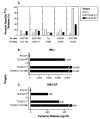Recombinant virus vaccination against "self" antigens using anchor-fixed immunogens
- PMID: 10363968
- PMCID: PMC2249691
Recombinant virus vaccination against "self" antigens using anchor-fixed immunogens
Abstract
To study the induction of anti-"self" CD8+ T-cell reactivity against the tumor antigen gp100, we used a mouse transgenic for a chimeric HLA-A*0201/H-2 Kb molecule (A2/Kb). We immunized the mice with a recombinant vaccinia virus encoding a form of gp100 that had been modified at position 210 (from a threonine to a methionine) to increase epitope binding to the restricting class I molecule. Immunogens containing the "anchor-fixed" modification elicited anti-self CD8+ T cells specific for the wild-type gp100(209-217) peptide pulsed onto target cells. More important, these cells specifically recognized the naturally presented epitope on the surface of an A2/Kb-expressing murine melanoma, B16. These data indicate that anchor-fixing epitopes could enhance the function of recombinant virus-based immunogens.
Figures



Similar articles
-
A single heteroclitic epitope determines cancer immunity after xenogeneic DNA immunization against a tumor differentiation antigen.J Immunol. 2003 May 15;170(10):5188-94. doi: 10.4049/jimmunol.170.10.5188. J Immunol. 2003. PMID: 12734366
-
Mature CD83(+) dendritic cells infected with recombinant gp100 vaccinia virus stimulate potent antimelanoma T cells.Ann Surg Oncol. 2002 May;9(4):411-8. doi: 10.1007/BF02573878. Ann Surg Oncol. 2002. PMID: 11986195
-
Recombinant fowlpox viruses encoding the anchor-modified gp100 melanoma antigen can generate antitumor immune responses in patients with metastatic melanoma.Clin Cancer Res. 2003 Aug 1;9(8):2973-80. Clin Cancer Res. 2003. PMID: 12912944 Free PMC article. Clinical Trial.
-
Biased epitope selection by recombinant vaccinia-virus (rVV)-infected mature or immature dendritic cells.Gene Ther. 2003 Sep;10(20):1754-65. doi: 10.1038/sj.gt.3302066. Gene Ther. 2003. PMID: 12939642 Free PMC article.
-
Identification of a MHC class II-restricted human gp100 epitope using DR4-IE transgenic mice.J Immunol. 2000 Apr 1;164(7):3535-42. doi: 10.4049/jimmunol.164.7.3535. J Immunol. 2000. PMID: 10725708 Free PMC article.
Cited by
-
Tumor regression and autoimmunity after reversal of a functionally tolerant state of self-reactive CD8+ T cells.J Exp Med. 2003 Aug 18;198(4):569-80. doi: 10.1084/jem.20030590. J Exp Med. 2003. PMID: 12925674 Free PMC article.
-
Cancer vaccines: translation from mice to human clinical trials.Curr Opin Immunol. 2018 Apr;51:111-122. doi: 10.1016/j.coi.2018.03.001. Epub 2018 Mar 16. Curr Opin Immunol. 2018. PMID: 29554495 Free PMC article. Review.
-
Mining the melanosome for tumor vaccine targets: P.polypeptide is a novel tumor-associated antigen.Cancer Res. 2001 Nov 15;61(22):8100-4. Cancer Res. 2001. PMID: 11719435 Free PMC article.
-
Mouse model for pre-clinical study of human cancer immunotherapy.Curr Protoc Immunol. 2015 Feb 2;108:20.1.1-20.1.43. doi: 10.1002/0471142735.im2001s108. Curr Protoc Immunol. 2015. PMID: 25640991 Free PMC article.
-
Building better vaccines: how apoptotic cell death can induce inflammation and activate innate and adaptive immunity.Curr Opin Immunol. 2000 Oct;12(5):597-603. doi: 10.1016/s0952-7915(00)00148-5. Curr Opin Immunol. 2000. PMID: 11007365 Free PMC article. Review.
References
-
- Hellstrom I, Hellstrom KE. Tumor vaccines—a reality at last? J. Immunother. 1998;21:119–126. - PubMed
-
- Mitchell MS. Immunotherapy of melanoma. J. Investig. Dermatol. Symp. Proc. 1996;1:215–218. - PubMed
-
- Fenton RG, Longo DL. Danger versus tolerance: paradigms for future studies of tumor-specific cytotoxic T lymphocytes. J. Natl. Cancer Inst. 1997;89:272–275. - PubMed
-
- Rosenberg SA, Yang JC, Schwartzentruber DJ, Hwu P, Marincola FM, Topalian SL, Restifo NP, Dudley ME, Schwarz SL, Spiess PJ, Wunderlich JR, Parkhurst MR, Kawakami Y, Seipp CA, Einhorn JH, White DE. Immunologic and therapeutic evaluation of a synthetic peptide vaccine for the treatment of patients with metastatic melanoma. Nat. Med. 1998;4:321–327. - PMC - PubMed
-
- Rosenberg SA, Zhai Y, Yang JC, Schwartzentruber DJ, Hwu P, Marincola FM, Topalian SL, Restifo NP, Seipp CA, Einhorn JH, Roberts B, White DE. Immunizing patients with metastatic melanoma using recombinant adenoviruses encoding MART-1 or gp100 melanoma antigens. J. Natl. Cancer Inst. 1998;90:1894–1900. - PMC - PubMed
MeSH terms
Substances
Grants and funding
LinkOut - more resources
Full Text Sources
Other Literature Sources
Research Materials
